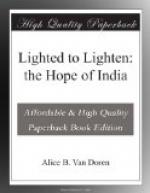It was at luncheon time that I found Mrs. Appasamy at home, and persuaded her by shortening her meal a bit to find time to sit down with me a few minutes and tell me of some of the opportunities that Madras offers to an Indian Christian woman with a desire for service.
For such service Mrs. Appasamy has unusual qualifications. The fifth woman to enter the Presidency College of Madras, she was one of those early pioneers of woman’s education, of whom we have spoken with admiring appreciation. Two years of association with Pandita Ramabai in her great work at Poona added practical experience and a familiarity with organization. Some years after her marriage to Mr. Appasamy, a barrister-at-law in Madras, came the opportunity for a year of foreign travel, divided between England and America. Such experiences could not fail to give a widened outlook, and, when Mrs. Appasamy returned to make her home in Madras, she soon found that not even with four children to look after, could her interests be confined to the walls of her own home.
American girls might be interested to know how wide a range of activities Indian life affords—how far the Western genius for organization and committee-life has invaded the East. Here is a partial list of Mrs. Appasamy’s affiliations:
Member of Council and Executive for the Women’s Christian College.
Vice President of the Madras Y.W.C.A.
Member of the Hostel Committee of the Y.W.C.A.
Member of the Vernacular Council of the Y.W.C.A.
Women’s Secretary for All India of the National Missionary Society.
Supervisor of a Social Service Committee for Madras.
President of the Christian Service Union.
Of all her activities, Mrs. Appasamy’s connection with the National Missionary Society is perhaps the most interesting. The “N.M.S.,” as it is familiarly called, is a cause very near to the hearts of most Indian Christians. The work in Dornakal represents the effort of Tinnevelly Tamil Christians for the evangelization of one section of the Telugu country. The N.M.S. is a co-ordinated enterprise, taking in the contributions of all parts of Christian India and applying them to seven fields in seven different sections of India’s great expanse. The first is denominational and intensive; the second interdenominational and extensive. India has room for both and for many more of each. Both are built upon the principle of Indian initiative and employ Indian workers paid by Indian money.
In the early days of the N.M.S., its missionaries were all men, assisted perhaps by their wives, who with household cares could give only limited service. Later came the idea that here was a field for Indian women. At the last convention, the question of women’s contribution and women’s work was definitely raised, and Mrs. Appasamy took upon herself the burden of travel and appeal. Already she has organized contributing branches among the women of India’s principal cities and is now anticipating a trip to distant Burmah for the same purpose. Rupees 8,000—about $2,300.00—lie in the treasury as the first year’s response, much of it given in contributions of a few cents each from women in deep poverty, to whom such gifts are literally the “widow’s mite.”




